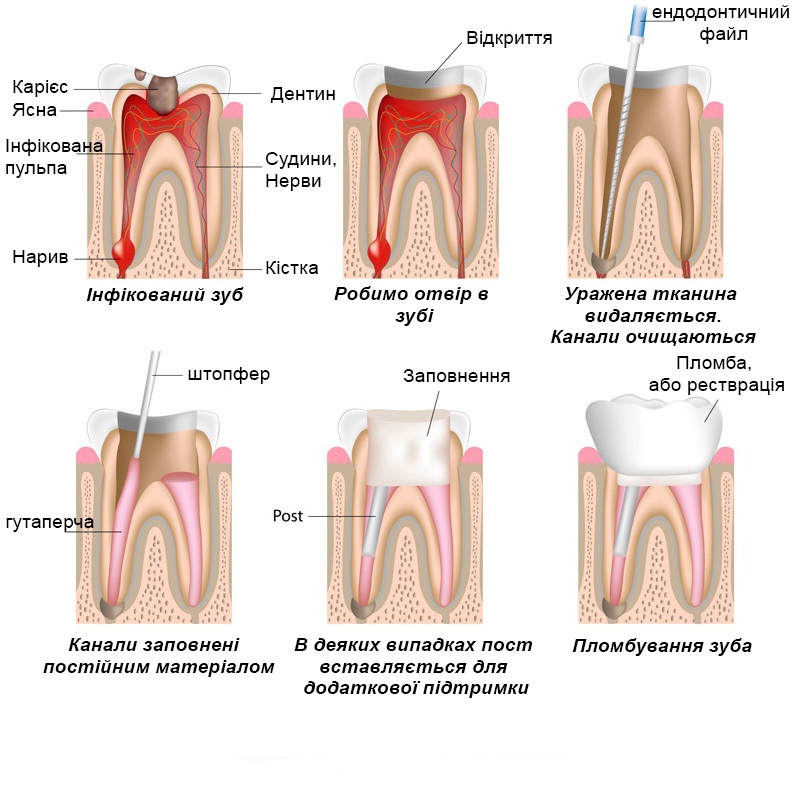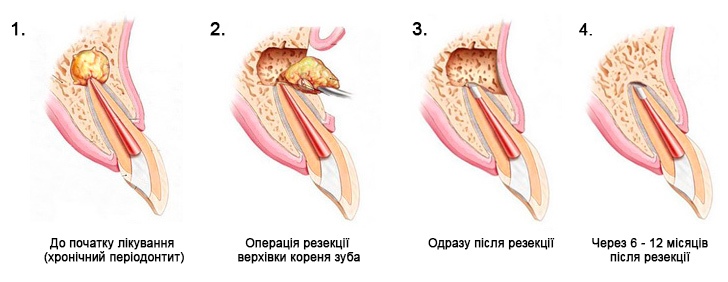Treatment of pulpitis - about complex dentistry in simple language
Pulpitis is a commonly used term for nerve inflammation (inflammation of the tooth pulp or inflammation of the vascular nerve bundle).
Our doctors have collected complete information about pulpitis - its features and treatment methods.

Causes of pulpitis.
The first reason that causes pulpitis is, of course, caries (you will learn about caries and how to deal with it in this article - believe me, something may be a revelation for you).
The next cause of pulpitis (rarely) is insufficient rinsing of the etching gel during the restoration of teeth with composite materials. When preparing the hard tissues of the tooth without water cooling, the pulp overheats, causing the pulp to become inflamed. You don't need to be a doctor to understand this.
Patient complaints - symptoms of pulpitis
As soon as the patient enters the office and says: "Doctor! I am in so much pain! This pain prevents me from living, sleeping, eating and drinking! Doctor, help me! "
It is then that the dentist will suspect that you have an inflammation of the vascular nerve bundle (pulpitis). The symptoms of pulpitis are clear, it is simply impossible not to pay attention to them! This is a sharp pain that becomes stronger in the evening or at night, you may feel that you are disturbed by a toothache in your sleep. The tooth reacts to cold and heat, and sometimes to loud noises. The pain may subside for a while and then reappear.
Remember, the only way to diagnose and properly treat pulpitis is to visit a dentist. A specialist will determine pulpitis both visually and with the help of an X-ray. Most often, both methods are used, since pulpitis can be confused with diseases that have similar symptoms (for example, "Periodontitis").
Methods of treatment of pulpitis
Untreated pulpitis can have serious complications. Inflammation begins in the ligaments of the tooth (periodontium), which can lead to periodontitis or complete tooth loss.
Sometimes complications arise due to poor-quality tooth treatment (improper filling of the tooth canals). Therefore, after the root canal filling procedure, be sure to take an X-ray. It will help the dentist to make sure that the treatment was of high quality. In most cases, people do not go to the clinic because of the fear of pain. Only high-quality anesthesia is used at Oleksiuk Dentistry, so the procedure is completely painless. The only thing that remains unpleasant is an injection into the gums for anesthesia. But compared to the pain of pulpitis, this is just an unpleasant moment.
Is it possible to treat pulpitis with folk remedies?
Pulpitis is treated only in a dental clinic. Self-treatment is impossible here! It's a pity to hear the stories of patients who tried to cure pulpitis with folk remedies (such as compresses or applying garlic to the gums). These folk methods of treating pulpitis will lead you to even more irritated gum mucosa or a burn. As a result, a person suffers not only from toothache but also from gum damage. Treatment of pulpitis at home with folk remedies is dangerous!
It will be better if you take better care of your oral hygiene and visit the dentist at least 2 times a year.
Conclusion - treatment of pulpitis requires complex techniques that directly depend on properly selected dental instruments, filling and medicinal materials. Oleksiuk Dentistry always uses every opportunity to maintain normal tooth vitality after pulp treatment.
Don't suffer from toothache! Go to dentistry in time. Our clinic will provide you with qualified dental care and eliminate pulpitis at any stage.
Treatment of periodontitis - always 32 with us.
Periodontitis is a complication of caries.
First of all, the tooth pulp is inflamed - its destruction occurs. Then the inflammatory process goes beyond the pulp and involves the ligamentous apparatus of the periosteum and bone.
Symptoms of periodontitis
Everyone knows the symptoms of periodontitis. A person has a feeling that a tooth has been pushed out (the feeling of a "protruding tooth" or "big tooth"). At the slightest pressure on the tooth or biting, severe pain is felt. There may also be redness in the area of the tooth.
There may be a complication, such as a fistula (a purulent disease that is an inflammation of the canal that connects the tooth itself and the outer part of the gum).
Treatment of periodontitis is mandatory, as further spread of the infection can lead to more serious diseases, such as periostitis (flux) and osteomyelitis. You also need to take into account that the most important human organs are located nearby - eyes, brain, etc., and periodontitis is a serious inflammatory process in the body that can be a catalyst for other sores.
You should immediately visit a dentist with a periodontitis problem.

We can say right away that home treatment of periodontitis can only take place in its initial stages. Further qualified treatment can only be provided by a dentist. In dentistry "Oleksiuk" periodontitis treatment is carried out with the help of the latest technologies and means available in our world.
Treatment of periodontitis
The treatment takes place in several stages. (Get ready for repeated visits to the dentist):
- First, an X-ray of the tooth is taken.
- With the help of the best modern anesthesia, pain relief is provided.
- Then the tooth cavity is opened - all the tissues affected by caries are removed, and access to the root canals is also opened.
- Necrotized pulp may be separated.
- If you have previously had your canals poorly sealed, then unsealing will be performed.
- Then, using special tools and technologies, the length of the root canals will be determined.
- Next, the root canals are mechanically processed - this is necessary for their expansion and for further high-quality filling of the canals.
- Then we treat the periodontitis itself. We inject medicinal substances that have antibacterial, antiviral, and anti-inflammatory effects through the open tooth crown. Thanks to these medications, the inflammation is relieved. The bone tissue and ligamentous apparatus of the tooth are formed again.
- A temporary filling is applied.
- After all inflammatory processes have subsided, you can start filling the tooth. At this stage, periodontitis can be considered curable. All that remains is to place a permanent filling, take a control X-ray and satisfy all the patient's aesthetic needs.
Prices for the treatment of periodontitis in Ternopil
You can find the prices for periodontitis treatment at "Oleksiuka" clinic at this link . Come to our clinic and we will definitely help you! Dentistry "Aleksyuka" works 365 days a year without days off and holidays. Thank you for your trust.
Dentistry "Oleksiuk" - it's easy to smile with us!
Treatment of tooth canals (Endodontics)
Caries is the cause of almost all dental problems, and root canal disease is no exception.
As it has been mentioned many times before, complicated caries is when carious processes go so deep that the tooth pulp, or, as our patients are used to saying, the nerve, is affected. "Big teeth" have several canals; in the central teeth, there are usually one or two.
If you do not seek qualified help in time, you will face serious complications. Granulomas and fluxes may form, which will result in tooth extraction.
Indications and stages of root canal treatment
We treat tooth canals when a patient comes to us with a significantly damaged tooth. We see the destroyed walls of the tooth, progressive deep caries, which has "eaten" all the hard tissues above the level of the nerve. Treatment of the pulp can also be carried out for orthopedic indications, or carried out for prosthetics.
In order to relieve inflammation in the root canal, the doctor needs to remove the infected pulp tissue, rinse and dry the canal thoroughly. It is impossible to completely remove the infection, because a large main root canal has a large number of branches (a system of micro tubules), which are almost impossible to clean and process mechanically. Therefore, we must reliably isolate them from the surrounding tissues. The quality of such treatment depends not only on the professional knowledge and skills of the endodontist, but also on the materials and equipment used during treatment.

A lot of auxiliary instruments and devices are used to make the pulp treatment procedure of the highest quality. The very first device is an assistant that allows you to determine the length of the root canal is an apex locator (as soon as the root needle of the device reaches the end, we hear a warning signal that allows us to understand that we have passed the tubules). It is important to remember that the apex locator may not show completely accurate data.
Using a special thin K-file instrument and an X-ray, we determine the exact length of the pulp. Since the K-file is X-ray contrast, the endodontist can see perfectly well whether the tip of this instrument has reached the apex of the root or not.
The tubules are given a special taper with the help of tools. They are treated mechanically and medically (with antiseptic agents). Ultrasound is used to get them into all microtubules and branches. The use of this technique allows you to cure root canal infection qualitatively and without complications. At the end of the treatment, the canal is filled.

Tooth restoration after root canal treatment
After performing the above steps, the tooth is restored from above. It all depends on how much the tooth is damaged. Accordingly: if the teeth are less than half destroyed, we restore them by filling; if the tooth is destroyed by more than half, we go through orthopedic stages of tooth restoration
In conclusion, we can say that the whole procedure of pulp treatment in dentistry "Oleksiuk" is PAINLESS and inexpensive! Our doctor - endodontist Ivan Yakymchuk - has deep knowledge and experience in edodontics, and has great patience.
You just need to call (0352) 40 00 08, (098) 130 13 71 You will receive the best dental care in Ternopil.
Tooth-preserving operations - we will save your teeth.
Dentistry is essential for maintaining strong and beautiful teeth.
There are cases when endodontic treatment does not help, so it is necessary to perform tooth-preserving operations. They can prevent diseases and restore a healthy appearance to your teeth.
How to prevent diseases of the teeth and gums?
Experts recommend listening to advice that will protect you from any type of surgery:
- Before brushing, be sure to floss with a special flosser. Carefully clean any free space between the teeth.
- Don't forget to brush your tongue, gums, and the inside of your cheeks.
- It is necessary to carry out the cleaning procedure in the morning and evening, because bacteria multiply every 12 hours.
- It is forbidden to drink a lot of strong tea and coffee, as these products stain the enamel.
- The oral cavity should be cleaned after every meal.
Please note! It is necessary to visit the dentist at least twice a year.
Resection of the apex of the tooth root
Tooth root resection is an operation to remove the infected area of the tooth that cannot be treated with conventional treatment. Root apex resection is performed on no more than one third of the tooth.

At the beginning of the operation, the dentist makes an incision in the gum at the site of the lesion. The focus of the infection is removed through the incision. The top of the root is removed, and now the filling begins from the inside. To inject a drug that activates and accelerates the regeneration process, an injection is made into the wound. Then the incision in the gum is sutured.
Please note! After the operation, the tooth continues to function normally.
Prices for tooth root resection depend on the condition of your teeth. You can find the price list on our website.
Tooth hemisection.
If there is an infection in the root area that cannot be eliminated by therapeutic treatment, then hemisection is performed. The infected root is removed from the adjacent crown part of the tooth, and the rest of the root, which is healthy and subject to treatment, remains.
The operation is as follows:
- The inflamed bundle is removed and the canals are filled.
- Part of the crown and root are separated - a thin layer of tooth enamel is removed.
- A cavity is formed in the mouth, which is filled with osteoplastic material (necessary for bone tissue restoration).
After all the procedures, the tooth must be given time to heal, after which it can fully perform all its intended functions.
Tooth root amputation
During the procedures, the affected part of the root is removed, while
the crown part remains intact. Such actions help to preserve the functionality and appearance of the tooth. After the operation, you can use this particular tooth as a pore.
Unlike hemisection, the crown part and physiological function of the tooth are preserved.
Attention: If a person has diabetes mellitus or blood diseases, it is contraindicated for him or her to undergo such an operation. Elderly people are also prohibited from undergoing root amputation, but the final decision is made during a consultation with a dentist.
The operation is as follows:
- A small incision is made on the gum.
- Then the surgeon cuts off and extracts the affected root from the socket.
- A cavity is formed, which must be cleaned and then filled with osteoplastic material.
- The flap is put back in place and the wound is sutured.
The operation is necessary in case of tooth root decay or abnormal root canal shape.
What should be the postoperative care?
Care should begin three days after surgery.

Be sure to follow the following procedures:
- Rinse your mouth with warm salted water after every meal;
- analgesics can eliminate pain;
- Drink a vitamin complex;
- take the medications prescribed by your dentist every day;
- do not neglect drugs that can strengthen the immune system.
Several times a day, examine your teeth for any abnormalities. If they are present, contact your dentist immediately.
Surgical lengthening of the crown part of the tooth - correction of a gum smile.
"Gum smile" - the crowns of the teeth look too short, which is why most of the gums are visible when smiling. Many people do not like it, so they have to go to a surgeon to lengthen the crown part. With the help of surgical lengthening, an ideal ratio of gums and dentition is created.
Modern specialists, thanks to anesthetics, are able to perform even a surgical operation painlessly. Only healthy tissues are suitable for the procedures, otherwise, all diseases must be cured. At the first stage, your task is to undergo an examination by a doctor who gives permission or, on the contrary, prohibits the procedures.
If you need to lengthen one tooth, the doctor performs a gingivotomy. Then the bone tissue is exposed, and a new contour is created. The dentist determines the connective tissue and biological width (should be 2-3 millimeters) during the operation.
Important! The doctor resects the bone tissue in the area of the tooth and then fixes the flap with sutures. Due to the high risk of the gum returning to its original state, resection is mandatory. The operation can be performed to restore the gum contour of not only one or more teeth, but also the entire dentition. The patient can remove the sutures after 3-5 days from the time of the operation. A special rinse is prescribed to strengthen the teeth and a beautiful smile. If you are sure that you need a surgeon's intervention, make an appointment for a consultation. Our dentist will consult you and then confirm or refute your concerns. You will be provided with a treatment plan and a list of medications with their current prices.